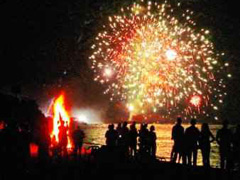


Do you know the real motive behind the Gunpowder Plot? Guy Fawkes may be the man we most commonly associate with the infamous scheme, but he didn’t act alone, nor was he in charge. Who did he work with, and why has his name become legendary rather than those of his co-conspirators?
Guy Fawkes was part of a group of 13 men who plotted to overthrow the Parliament. The reason was religion - Church of England was enforced, therefore Catholics and believers of other religions were given a very hard time by Queen Elizabeth I, as had been the case with several reigning monarchs before her. Non-Anglicans were forced to go to Anglican mass and were penalised with fines if they did not. It was hoped that Elizabeth’s successor, James I, would change things – after all he was married to a Catholic - however this was not to be. The men decided that the only solution was to blow up the Houses of Parliament, along with the King and members of his government.
There was a second motive behind the plot: James I was Scottish, and had formerly been King James VI of Scotland. This was the first time Scotland and England were ruled by the same person and many English people resented this. When Fawkes confessed his part in the crime, he stated that him and his cohorts wanted to “blow the Scotsman back to Scotland”.
\n\nAlthough Guy Fawkes is the name that appears most frequently in history books, the leader of the group was in fact Robert Catesby. Fawkes was the one caught in the act however; he was in charge of igniting the gunpowder as he had previous experience of using explosives in Holland. All 13 conspirators were from wealthy backgrounds, with the exception of Thomas Bates, who was a servant of Catesby. Guy Fawkes himself was a nobleman.
The Gunpowder Plot took 18 months of preparation. The group got hold of 36 barrels of gunpowder which they stashed in the cellar of the Houses of Parliament in late October 1605. November 5th was the date chosen for them to strike, as this was the day James I opened Parliament. After the death of King James, the plan was to kidnap his daughter Elizabeth, make her queen and arrange for her to wed a Catholic.
The plot was rumbled at the last minute. Legend has it that one of the group had second thoughts upon realising that innocent people would be harmed. He supposedly wrote an anonymous letter to one Lord Monteagle, telling him to stay away from Parliament on the day in question. King James got hold of this letter and sent his men down to the cellar, where they found Fawkes surrounded by the explosives. However it is now believed the letter never existed, and that the King was aware of the plot. In fact, most of the conspirators were known to the authorities for previous acts of treason.
A different theory says that the letter did exist, but didn’t mention the whereabouts of the explosion, in which case how would King James have instantly known to send his guards to the cellar? Another rumour points to a fundamental flaw in the plan: that the gunpowder was too old to ignite, which adds validity to the theory that it was all a set up by the government to fuel their anti-Catholic activities.
\n\nGuy Fawkes initially refused to speak, so he was tortured till he gave the names of his co-conspirators. This was in fact illegal in the 17th century, and King James had to seek a special licence to be able to torture the prisoner. Fawkes was executed for treason on January 31st 1606 in the garden of St. Paul’s Cathedral. The brutal method to be employed was hanging, drawing and quartering – this meant hanging, cutting off the genitals, removing the bowels and the heart to be burnt while the prisoner was still alive, then cutting off the head and limbs. To avoid this fate Fawkes jumped while climbing up to the hanging platform, breaking his neck and dying immediately.
As his fellow conspirators were tortured, it is likely that they offered names of people who had little to do with the plot, but satisfied the officers’ enquiries. The government took advantage of the Gunpowder Plot to stir further anti-Catholic sentiment in the UK, and it is believed many innocent people who they felt undermined their rule were executed.
Bonfires were lit the night Fawkes was caught, to celebrate that the King was safe. This marked the very first Bonfire Night, or Guy Fawkes Night as it’s also known. It has since become tradition to make effigies of Guy Fawkes out of newspaper, hay and/or fabric and toss them onto a bonfire after a firework display (over the years other reviled figures have been burnt in this way, among them Margaret Thatcher). Before burning them, children would display them and ask passers-by for “a penny for the guy”.
Other trivia:
As a result of the Gunpowder Plot, the ruling monarch only attends Parliament once a year, and the Yeomen of the Guard always inspect the cellars beforehand.
Historians claim that referring to a person as a “guy”, derives from Guy Fawkes, because of the many “guys” thrown on to the top of bonfires.
There is an island in the Galapagos called Guy Fawkes Island. It is uninhabited, and it is not known why it’s named after the notorious British figure.
In 2002 Guy Fawkes was voted the 30th Greatest Briton in a BBC poll, proving that the public love a bit of anarchy.


